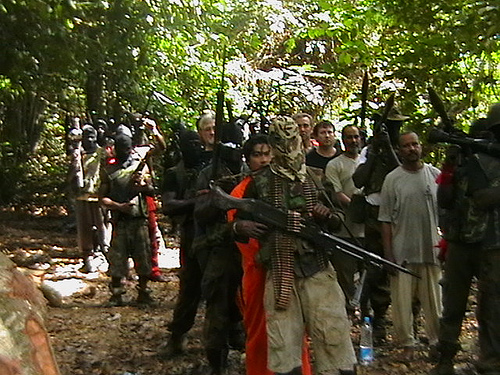
This blog is part of a series of contributions documenting time spent in southern Nigeria to attend a conference and gather data for the targeting energy infrastructure (TEI) project.
Monday morning, while sitting in my host office at the Institute for Dispute Resolution (IDR) – a NGO based in Ekpan, Nigeria (a community next to Warri) and headed by Innocent Adjenughure – a thunderous noise caught my attention. I paused as the word bomb came to mind. After all, I was sitting in the heart of the Niger Delta, where up until October 2009 when an amnesty deal was achieved, the resource rich region was wrought with militancy and criminality. The emergence of the Movement for the Emancipation of the Niger Delta (MEND), a militant umbrella group, in 2005/6 introduced an intensified campaign of violence aimed largely at the country’s oil and gas sector that crippled production by as much as 30 percent.
So I waited and listened. In the absence of emergency sirens or some type of notification, I shrugged, passing it off as an approaching storm.
What I didn’t realize was that nearby the post-amnesty dialogue “Restoring Hope in the Niger Delta”, initiated by the Vanguard Newspaper in Nigeria and sponsored by the federal government and the nine states in the Niger Delta region, was kicking off at the Delta State Government Annex building in Warri. In fact, Innocent and I were scheduled to attend this meeting but mistakenly thought that the program began the following day. So as prominent government officials and stakeholders began to gather just before 11:00, the first of 2 car bombs, planted by MEND and parked on the street outside of the compound, were remotely detonated. Shortly after, the second bomb went off. By noon, participants were fleeing the area in panic, numbers were injured and at least two civilians were reportedly killed.
Receiving word of the attack, we jumped on the road and headed toward the government building. I know: Not the smartest thing to do. The fear and tension grew as we approached the area. Cars were turning around and people were running away. Smoke could be seen ahead. Uncertain whether more attacks were planned and concerned about our personal safety amongst the crowd of scared civilians and security personnel on the defensive, we turned around only to return roughly three hours later. By 16:00 the road to the location of the attack was a much different scene. Gone were the people, cars and even military and police personnel. There was not even a barricade around the site. As we drove slowly past the remains of the first car bomb, we were struck by the twisted, burnt-out metal that was once a car. Smoke still lingered in the air while debris was strewn across the road. On the opposite side of the street, where the government building stands, we saw similar images. The car used for the second bomb was unrecognizable, and one could see that other cars that must have been parked nearby at the time of detonation were severely damaged.
Deciding to remain in the car and circle the area a few times while we captured video and photos, I couldn’t help but notice that the bombs used were low impact. Remove the debris and remnants of the cars, and one would not know that an attack took place. The road was in good shape (no craters from the blast) and, outside of some shattered windows, the damage to the government building was minimal. Clearly MEND sought not to cause casualties but rather to use (what I would define) as an act of terrorism to cause fear in those supporting this gathering and communicate a broader political message. Not only did they successfully prevent this meeting from proceeding, but they also proved that they continue to be a potent force, capable of stepping up another round of attacks that could produce another – perhaps more destructive – phase of instability in the region.
It bears mentioning that moments prior to the bombing, MEND sent an email to reporters warning that an attack aimed at the meeting was imminent and called for evacuations so that civilians would be spared. The extensive statement further claimed that the attack sought to communicate that “the deceit of endless dialogue and conferences will no longer be tolerated,” noting that more attacks aimed at oil installations – in particular those owned by companies such as the Total Corporation which have not been targeted in the past – were in the queue. The group also claimed that a third, more powerful bomb was planned. However, they decided to abort the detonation due to the mass hysteria caused by the two car bombs and the likelihood that another explosion would result in more casualties.
From where I stand, the situation in the Niger Delta sits at a vary precarious stage. Frustrations are high, and the conflict economy is tremendously complex and profitable. Today, Warri is calm. However I can’t help but sense an uneasy feeling in the air. In which direction will the region go? The coming weeks will provide some answers.

